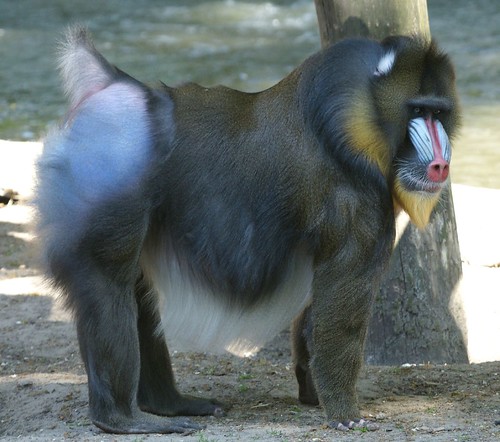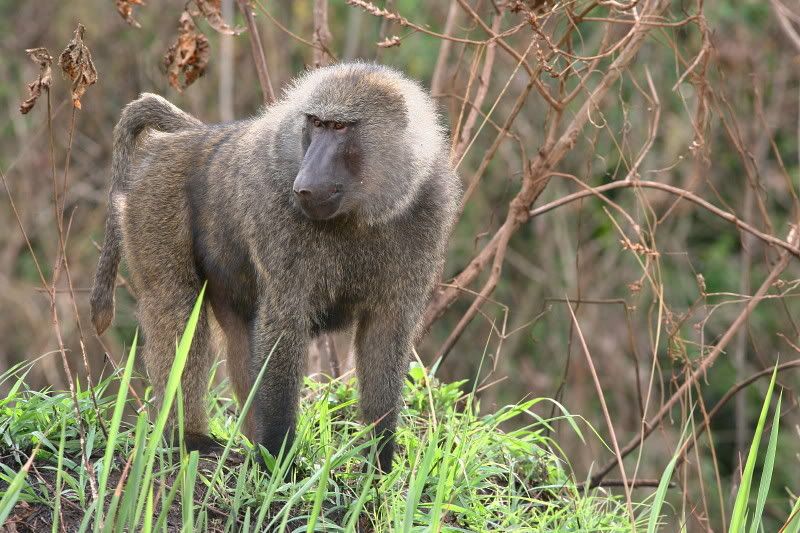Post by dinosauria101 on Jul 3, 2019 17:27:27 GMT 5
Mandrill - Mandrillus sphinx
The mandrill (Mandrillus sphinx) is a primate of the Old World monkey (Cercopithecidae) family, closely related to the baboons and even more closely to the drill. It is found in southern Cameroon, Gabon, Equatorial Guinea, and Congo. Mandrills mostly live in tropical rainforests and forest-savanna mosaics. They live in groups called "hordes". Mandrills have an omnivorous diet consisting mostly of fruits and insects. Their mating season takes place from June to October. Males average 25–35 kg (55-77 lb); females are less than half that weight (11–14 kg, or 25-30 lb). Unusually large males can weigh 50 kg (110 lb). The average male is 81–90 cm (32–36 in) and the female is 56–66 cm (22–26 in), with the tail adding another 5–8 cm (2–3 in). They can survive up to 31 years in captivity. Females reach sexual maturity at about 3.5 years. The mandrill has one of the greatest sexual dimorphisms among the primates.

Olive Baboon - Papio anubis
The olive baboon (Papio anubis), also called the Anubis baboon, is a member of the family Cercopithecidae (Old World monkeys). The species is the most widely ranging of all baboons: it is found in 25 countries throughout Africa, extending from Mali eastward to Ethiopia and Tanzania. Isolated populations are also found in some mountainous regions of the Sahara. It inhabits savannahs, steppes, and forests. The olive baboon is named for its coat, which, at a distance, is a shade of green-grey. (Its alternate name comes from the Egyptian god Anubis, who was often represented by a dog head resembling the dog-like muzzle of the baboon.) At closer range, its coat is multi-colored, due to rings of yellow-brown and black on the hairs. The hair on the baboon's face, however, is coarser and ranges from dark grey to black. This coloration is shared by both sexes, although males have a mane of longer hair that tapers down to ordinary length along the back. Besides the mane, the male olive baboon differs from the female in terms of size and weight; males are, on average, 70 cm (28 in) tall and weigh 24 kg (53 lb); females measure 60 cm (24 in) and 14.7 kg (32 lb). Some males may weigh as much as 50 kg (110 lb). Olive baboons are sexual dimorphic in body and canine tooth size.

Credit to Wikipedia
The mandrill (Mandrillus sphinx) is a primate of the Old World monkey (Cercopithecidae) family, closely related to the baboons and even more closely to the drill. It is found in southern Cameroon, Gabon, Equatorial Guinea, and Congo. Mandrills mostly live in tropical rainforests and forest-savanna mosaics. They live in groups called "hordes". Mandrills have an omnivorous diet consisting mostly of fruits and insects. Their mating season takes place from June to October. Males average 25–35 kg (55-77 lb); females are less than half that weight (11–14 kg, or 25-30 lb). Unusually large males can weigh 50 kg (110 lb). The average male is 81–90 cm (32–36 in) and the female is 56–66 cm (22–26 in), with the tail adding another 5–8 cm (2–3 in). They can survive up to 31 years in captivity. Females reach sexual maturity at about 3.5 years. The mandrill has one of the greatest sexual dimorphisms among the primates.

Olive Baboon - Papio anubis
The olive baboon (Papio anubis), also called the Anubis baboon, is a member of the family Cercopithecidae (Old World monkeys). The species is the most widely ranging of all baboons: it is found in 25 countries throughout Africa, extending from Mali eastward to Ethiopia and Tanzania. Isolated populations are also found in some mountainous regions of the Sahara. It inhabits savannahs, steppes, and forests. The olive baboon is named for its coat, which, at a distance, is a shade of green-grey. (Its alternate name comes from the Egyptian god Anubis, who was often represented by a dog head resembling the dog-like muzzle of the baboon.) At closer range, its coat is multi-colored, due to rings of yellow-brown and black on the hairs. The hair on the baboon's face, however, is coarser and ranges from dark grey to black. This coloration is shared by both sexes, although males have a mane of longer hair that tapers down to ordinary length along the back. Besides the mane, the male olive baboon differs from the female in terms of size and weight; males are, on average, 70 cm (28 in) tall and weigh 24 kg (53 lb); females measure 60 cm (24 in) and 14.7 kg (32 lb). Some males may weigh as much as 50 kg (110 lb). Olive baboons are sexual dimorphic in body and canine tooth size.

Credit to Wikipedia


